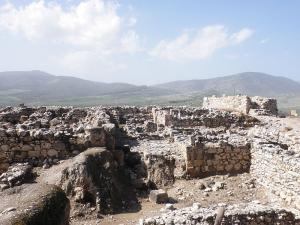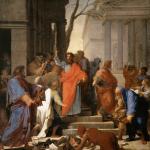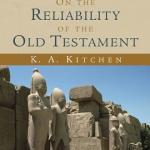Including Possible Archaeological Evidence for the Battle of Deborah in Judges 4
Bart Ehrman is one of the most well-known and influential critics of traditional Christianity and the inspired Bible (“anti-theists”) writing today. Formerly, in his own words, he was “a fundamentalist for maybe 6 years; a conservative evangelical but not extreme right wing for maybe 5 years more; and a fairly mainstream liberal Christian for about 25.” The primary reason he gives for having lost his faith is the problem of evil (a very serious topic I have dealt with many times). He stated on 3-18-22 in a comment on his blog: “I could no longer explain how there could be a God active in this world given all the pain and misery in it.” I don’t question his sincerity, good intentions, intellectual honesty, or his past status as a Christian; only various opinions which Christians must (in consistency) regard as erroneous.
Dr. Ehrman “received his PhD and MDiv from Princeton Theological Seminary, where he studied textual criticism of the Bible, development of the New Testament canon and New Testament apocrypha under Bruce Metzger.” He has written 30 books, which have sold over two million copies and have been translated into 27 languages.
Ehrman explains that the purpose of his blog is “to disseminate scholarly knowledge of the New Testament and the earliest periods of the Christian church to a non-scholarly audience, . . . Every post is rooted in scholarship – not just my own but that of thousands of scholars who have worked for centuries on understanding the historical Jesus, the New Testament, and the origins of Christianity.” Well, the conclusions of scholars are only as good as the solidity and truthfulness of the premises by which they are operating.
This is one of a series of reply-papers, in which I will address many of his materials from the perspective of archaeology, history, and exegesis.
*****
I am responding to his article, Israel’s Conquest of the Promised Land: Did Any of That Happen? (8-25-21). His words will be in blue.
I want to address a question lots of people typically have about these stories of the Conquest of Canaan in the book of Joshua. Did any of this happen?
Here’s how I discuss the matter in my book The Bible: A Historical and Literary Introduction (Oxford University Press), a book you should consider getting if you’re interested in knowing both what’s in the Bible and what scholars say about it from historical and literary perspectives. . . .
[T]he narratives of Joshua . . . are clearly molded according to theological assumptions and perspectives. There is almost nothing in the accounts that suggest that the author is trying to be purely descriptive of things that really happened. He is writing an account that is guided by his religious agenda, not by pure historical interests. That is why, when read closely, one finds so many problems with the narratives. . . .
Joshua 11:10-13 (RSV) And Joshua turned back at that time, and took Hazor, and smote its king with the sword; for Hazor formerly was the head of all those kingdoms. [11] And they put to the sword all who were in it, utterly destroying them; there was none left that breathed, and he burned Hazor with fire. [12] And all the cities of those kings, and all their kings, Joshua took, and smote them with the edge of the sword, utterly destroying them, as Moses the servant of the LORD had commanded. [13] But none of the cities that stood on mounds did Israel burn, except Hazor only; that Joshua burned. (“Jabin king of Hazor” was referred to in 11:1)
Ehrman makes the patently, demonstrably false statement:
- In the archaeological record there is no support for the kind of violent destruction of the cities of Canaan – especially the ones mentioned in Joshua. Think for a second: if one were to look for archaeological evidence, or other external verification, to support the historical narratives of Joshua, what would one look for?
- References to the invasion and conquest in other written sources.
- Evidence that there were indeed walled cities and towns in Canaan at the time.
- Archaeological evidence that the cities and towns mentioned actually were destroyed at the time (Jericho, Ai, Heshbon, etc.). . . .
And what kind of verification do we actually get for the narratives of Joshua? None of the above. There are no references in any other ancient source to a massive destruction of the cities of Canaan. There were few walled towns at the time. Many of the specific cities cited as places of conquest did not even exist as cities at the time.
At the moment, I am dealing with only Hazor. I’ll get to many other cities in due course (I have the time, since I am a full-time apologist). Remember, Ehrman claimed there was “no support . . . none” for “violent destruction of the cities of Canaan – especially the ones mentioned in Joshua”: as I detail the actual, specific archaeological evidence that he thinks is nonexistent. It’s easy (and very foolish) to make “universal negative” statements. And it’s easy as pie to shoot them down. Even a single counter-example already logically demolishes such sweeping and “triumphalistic” claims. But I will produce many counter-examples in this and other similar articles to come.
Hazor, according to archaeology (1), was “destroyed along with a massive conflagration in the thirteenth century, probably toward its end” (exactly the time period of Joshua).
In 1996 rather sensational charred remains of a late Bronze Age palace were discovered in excavations led by Amnon Ben Tor. That this was the work of the Israelites was suggested by the “deliberate decapitation and mutilation of statues of deities, in keeping with the charge of Moses to the Israelites in Deuteronomy 7:5”. “The emerging picture, . . . is consistent with the description of the sack of Hazor in Joshua 11.” (2)
Eero Junkkaala wrote at length specifically about this general topic and noted that four Israeli archaeologists (Yadin, Aharoni, Ben-Tor, and Frankel) agreed and concluded that the city was destroyed militarily by the Israelites. Frankel wrote about it: “the archaeological finds ostensibly correlate with the biblical description: a Canaanite city was totally destroyed and a small Iron I village was built upon its ruins.” (3).
In stratum XIII, the last of the Bronze Age strata, the building [“probably a palace”] was destroyed by fire. (4)
Rafael Frankel [see his book], also maintained that “in the case of the conquest of Hazor too, the archaeological finds ostensibly correlate with the biblical description: a Canaanite city was totally destroyed and a small Iron I village was built upon its ruins.”
Footnotes:
(1) Kenneth A. Kitchen, On the Reliability of the Old Testament (Grand Rapids and Cambridge: William B. Eerdmans Publishing Company, 2003), 185.
(2) James K. Hoffmeier, Israel in Egypt: The Evidence for the Authenticity of the Exodus Tradition (New York, Oxford: Oxford University Press, 1996), 35.
(3) Eero Junkkaala, Three Conquests of Canaan: A Comparative Study of Two Egyptian Military Campaigns and Joshua 10-12 in the Light of Recent Archaeological Evidence (Finland: Abo Akademie University Press, 2006); citations from pages 230-231, 233-234.
(4) Avraham Negev and Shimon Gibson, Archaeological Encyclopedia of the Holy Land (New York: Continuum, revised edition of 2001), 78.
Even Ehrman concedes in his article that Hazor was “wiped out at about the right time,” which of course contradicts his earlier statement that there was “no support . . . none“ [my italics] for the “violent destruction of the cities of Canaan”. Which is it? Perhaps Ehrman can explain to us this discrepancy in his argument. In any event, the evidence for the burning destruction of Hazor in Joshua’s time is clear and incontrovertible.
Now we can deal with the topic of Judges 4, which Ehrman takes to be a biblical contradiction. He writes:
In ch. 11 [of Joshua], for example, the Israelite forces completely annihilate the city of Hazor: . . . If that were true, why is it that in the next book, Judges, the Canaanites still very much live in and control Hazor, under their king Jabin, whose powerful army afflicted and oppressed the Israelites (Judges 4)?
The battle is described in Judges 4:1-24 (the entire chapter), complete with references to “Jabin king of Canaan, who reigned in Hazor” (4:2), “Jabin the king of Hazor” (4:17), “Jabin the king of Canaan” (twice in 4:23-24), and “Jabin king of Canaan” (4:24). There is no mention, by the way, in this second incident, of Hazor being burned or destroyed; only that Jabin was “destroyed.” This corresponds with the archaeology that likewise doesn’t show a second destruction at this time.
So of course, the skeptics and atheists have had a grand time mocking this, since the city was burned in Joshua 11, and here it is again, with the same king? How hilarious, huh? The only problem is that there is a long time gap involved, which Ehrman neglects (he acts as if the two events were close in time). In fact, Judges 3:11 states that “the land had rest forty years” and notes that the first Judge Othniel died. Judges 3:30 then informs us that “the land had rest for eighty years.” By my math that is at least 120 years that had passed since Joshua’s destruction of Hazor, and this second battle led by Deborah, who is brought up five verses later.
The first battle was around 1230-1200 BC, according to archaeologist and Egyptologist Kitchen, and several other prominent archaeologists. But when is the time period of Deborah? It so happens that recently, archaeologists believe they may have found evidence of the town Haro’sheth-ha-goiim, where Deborah’s nemesis Sisera dwelt (Jud 4:2). El Ahwat is now believed to possibly be the location (as reported in The Jerusalem Post on 11-27-19). A chariot linchpin was found on the site, as Wikipedia reports. 900 chariots were involved in this battle (Jud 4:7, 15-16).
Wikipedia also noted that the well-known Israeli archaeologist Israel Finkelstein dated the site at around 1060-1050 BC [Finkelstein, I. and Piasetzky, E. 2007. Radiocarbon Dating and Philistine Chronology with an Addendum on el-Ahwat. Ägypten und Levante: Internationale Zeitschrift für ägyptische archäologie und deren nachbargebeite Vol. 17.]. Wikipedia (“Deborah”) states that “Traditional Jewish chronology places Deborah’s 40 years of judging Israel (Judges 5:31) from 1107 BC until her death in 1067 BC” [see further source].
As one can see, the dates almost line up with Finkelstein’s scholarly archaeological opinion. A. D. H. Mayes, in his article, “The Historical Context of the Battle against Sisera”, Vetus Testamentum. 19 (3) [1969]: 353–360 [download a PDF copy at an article site] also believes that the most likely period for this battle was somewhere between 1050-1000 BC.
So how do such judgments correspond with the biblical data? They do quite strikingly. The Bible notes at least a 120-year gap between Joshua and Deborah and this second battle. The late estimate for the first battle (1200 BC) is 140 or 150 years earlier than Finkelstein’s estimate, and 150-200 years earlier from that of Mayes. Given the inexact nature of much archaeological speculation, that is very good correspondence indeed; there may very well be more unmentioned years passed, according to the Bible, and so it is seen that the Bible is (for the zillionth time) historically accurate and (conversely) not definitely in error.
Ehrman (as I would have suspected) is rather fond of Israel Finkelstein. He thinks his 2002 book, The Bible Unearthed, is “absolutely terrific . . . Really great, in every way”, and that Finkelstein and co-author Neil Asher Silberman are “highly established and incredibly learned scholars who seem to know everything relevant to the Hebrew Bible . . . far more qualified than I to say anything about the history of ancient Israel” (“Did David Exist? And When Did I Know I Lost My Faith?”, 4-15-17).
All this being the case, Ehrman’s objection basically vanishes to nothing. It’s not unthinkable at all for a town to rebuild itself in a period of 140-200 years. Archaeologist Rafael Frankel stated about Hazor, that “a small Iron I village was built upon its ruins.” That’s all we need to know. It was in existence (again) at the time of Deborah’s battle.
The only remaining problem is the multiple mention of king Jabin. It appears, in light of all of the above, that there simply were two people with this same name. This is not unusual at all, when we look at the history of kings all over the world. A list of Assyrian kings, for example, shows many examples of multiple king names (indicated by “II”, “III”, “IV”, or “V” after the names): most of them closer in time to each other than the 120-year minimum spread between the two Jabins. Scottish kings show the same tendency; as do Egyptian pharaohs and no doubt many other (if not all other) such lists. The most famous multiple names perhaps come from the French monarchs, with 19 kings named Louis and ten named Charles. So that is a non-issue.
With that settled, Ehrman’s entire objection — at least in my humble opinion — vanishes, in light of what we know from secular archaeological science and history (not simply biased Christian apologetics or internal Christian arguments from the Bible).
***
See the related paper, Pearce’s Potshots #41: 13th c. BC Canaanite Iron Chariots [7-16-21]
***
Practical Matters: Perhaps some of my 4,000+ free online articles (the most comprehensive “one-stop” Catholic apologetics site) or fifty books have helped you (by God’s grace) to decide to become Catholic or to return to the Church, or better understand some doctrines and why we believe them.
Or you may believe my work is worthy to support for the purpose of apologetics and evangelism in general. If so, please seriously consider a much-needed financial contribution. I’m always in need of more funds: especially monthly support. “The laborer is worthy of his wages” (1 Tim 5:18, NKJV). 1 December 2021 was my 20th anniversary as a full-time Catholic apologist, and February 2022 marked the 25th anniversary of my blog.
PayPal donations are the easiest: just send to my email address: [email protected]. You’ll see the term “Catholic Used Book Service”, which is my old side-business. To learn about the different methods of contributing, including 100% tax deduction, etc., see my page: About Catholic Apologist Dave Armstrong / Donation Information. Thanks a million from the bottom of my heart!
***
Photo credit: Qasinka (2-9-13). Ruins of Hazor [public domain / Wikimedia Commons]
***
Summary: Agnostic Bible skeptic Bart Ehrman makes several objections regarding Hazor and the “conquest” of Canaan by the Israelites. I provide strong counter-arguments.














